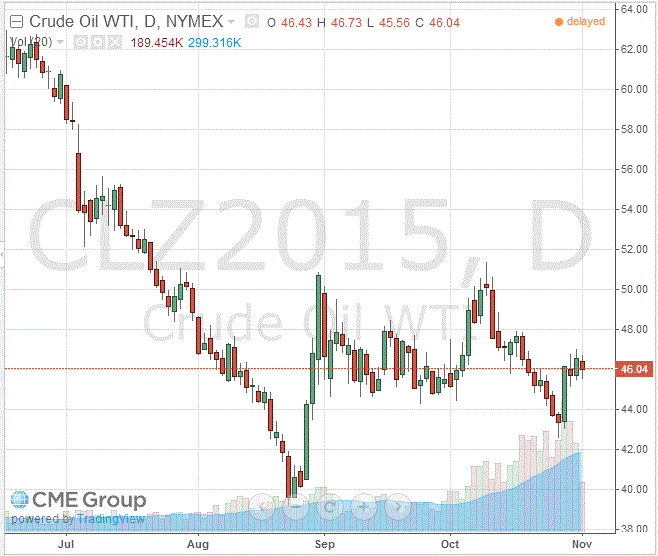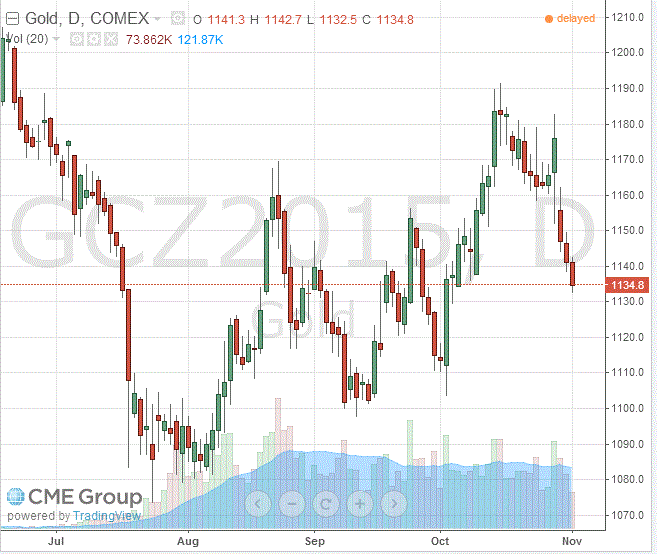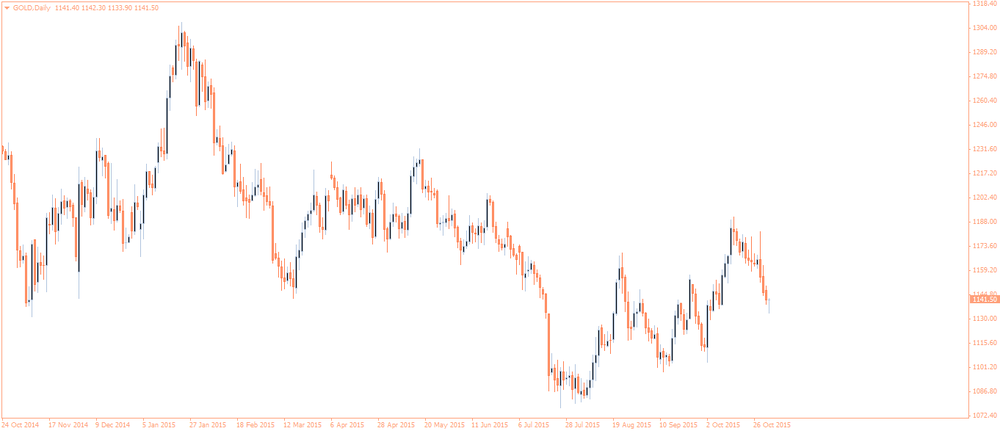Noticias del mercado
-
17:46
Oil prices decrease on the Chinese economic data and on oil output data from Russia
Oil prices fell on the Chinese economic data and on oil output data from Russia. Russia produced 10.78 million barrels per day in October. The country tries to defend its market share.
The Chinese preliminary Markit/Caixin manufacturing Purchasing Managers' Index (PMI) rose to 48.3 in October from 47.2 in September, exceeding expectations for a rise to 47.5. A reading below 50 indicates contraction of activity. The index was driven by a slower contraction of new business.
Market participants also eyed the U.S. rigs data. The oil driller Baker Hughes reported on Friday that the number of active U.S. rigs declined by 16 rigs to 578 last week. It was the ninth consecutive decrease and the lowest level since June 18, 2010. Combined oil and gas rigs declined by 12 to 775. It was the lowest level since April 2002.
WTI crude oil for December delivery decreased to $46.04 a barrel on the New York Mercantile Exchange.
Brent crude oil for December fell to $48.83 a barrel on ICE Futures Europe.
-
17:30
Gold price falls on speculation that the Fed will start raising its interest rate this year
Gold price decline on speculation that the Fed will start raising its interest rate this year. The Fed released its interest rate decision last Wednesday. The Fed kept its interest rate unchanged at 0.00%-0.25%. This decision was widely expected by analysts.
The Fed pointed out that an interest rate hike in December is still on the table.
Market participants eyed the U.S. economic data. The Institute for Supply Management released its manufacturing purchasing managers' index for the U.S. on Monday. The index declined to 50.1 in October from 50.2 in September, beating expectations for a fall to 50.0. It was the lowest level since May of 2013.
Markit Economics released its final manufacturing purchasing managers' index (PMI) for the U.S. on Monday. The U.S. final manufacturing purchasing managers' index (PMI) increased to 54.1 in October from 53.1 in September, up from the previous estimate of 54.0.
December futures for gold on the COMEX today declined to 1134.80 dollars per ounce.
-
16:30
ISM manufacturing purchasing managers’ index falls to 50.1 in October, the lowest level since May of 2013
The Institute for Supply Management released its manufacturing purchasing managers' index for the U.S. on Monday. The index declined to 50.1 in October from 50.2 in September, beating expectations for a fall to 50.0. It was the lowest level since May of 2013.
A reading above 50 indicates expansion, below indicates contraction.
The decline was partly driven by a fall in production. The employment index was down to 47.6 in October from 50.5 in September.
The production index increased to 52.9 in October from 51.8 in September.
The new orders index rose to 52.9 in October from 50.1 in September.
The price index was up to 39.0 in October from 38.0 in September.
-
10:43
Chinese preliminary Markit/Caixin manufacturing Purchasing Managers' Index rises to 48.3 in October
The Chinese preliminary Markit/Caixin manufacturing Purchasing Managers' Index (PMI) rose to 48.3 in October from 47.2 in September, exceeding expectations for a rise to 47.5.
A reading below 50 indicates contraction of activity.
The index was driven by a slower contraction of new business.
"The slight upswing shows the manufacturing industry's overall weakening has slowed down, indicating that previous stimulating measures have begun to take effect. Weak aggregate demand remained the biggest obstacle to economic growth, and the risk of deflation resulting from the continued fall in the prices of bulk commodities needs attention," Dr. He Fan, Chief Economist at Caixin Insight Group, said.
-
10:27
Standard & Poor’s cuts Saudi Arabia’ credit rating to A+
Ratings agency Standard & Poor's (S&P) on Friday lowered Saudi Arabia' credit rating to A+ from AA-. The outlook is negative.
The agency noted falling oil prices will lead to a wider government deficit. According to S&P, the country's deficit could rise to 16% of gross domestic product (GDP) this year from 1.5% in 2014.
-
10:19
The number of active U.S. rigs falls by 16 rigs to 578 last week
The oil driller Baker Hughes reported on Friday that the number of active U.S. rigs declined by 16 rigs to 578 last week. It was the ninth consecutive decrease and the lowest level since June 18, 2010.
Combined oil and gas rigs declined by 12 to 775. It was the lowest level since April 2002.
-
10:09
The Wall Street Journal’s poll: investment banks expect Brent crude to be $58 a barrel and WTI crude to be $54 a barrel next year
According to The Wall Street Journal poll, 13 investment banks expect Brent crude oil price will average $58 a barrel and West Texas Intermediate (WTI) crude oil price will average $54 a barrel next year.
Many of these banks forecasted crude oil price above $70 a barrel a few months ago.
-
08:13
Oil prices under pressure
West Texas Intermediate futures for December delivery fell to $46.40 (-0.41%), while Brent crude is currently at $49.62 (+0.06%). Oil prices weakened after a report on Chinese manufacturing showed that economic activity contracted in the sector in October although it still posted the best result in four months. The Markit/Caixin Manufacturing Purchasing Managers' Index came in at 48.3 in October compared to expectations for a 47.5 reading and 47.2 reported previously. China is the second-biggest oil consumer in the world, that's why weak manufacturing activity in this country suggests that it will not boost demand and global markets will remain oversupplied.
Barclays said that China's oil demand growth, adjusted for inventories, slowed to 226,500 barrels per day, or 2.1%, in September compared with the same month last year, much lower than the 6.3% gain recorded for the first three quarters of the year.
"Fundamentals suggest moderate demand ahead, in our view," the bank said.
-
08:05
Gold stabilized after falling earlier in the session
Gold is currently at $1,141.80 (+0.04%) near its open level after touching a four-week low earlier today. Expectations that the Federal Reserve can still raise interest rates till the end of the year continue weighing on this non-interest-paying asset. Higher rates would decrease demand for gold further. Gold had advanced last month on speculation that the general weakness in the global economy could persuade the central bank of the U.S. to delay the rate hike to next year, but the latest Fed monetary policy statement suggested that a rate hike in December was still possible.
Assets in SPDR Gold Trust, world's largest gold-backed exchange-traded fund, fell 0.3% to 692.26 tonnes on Friday. Physical demand remained weak.
-
00:33
Commodities. Daily history for Sep Oct 30’2015:
(raw materials / closing price /% change)
Oil 46.39 -0.43%
Gold 1,141.70 +0.03%
-


